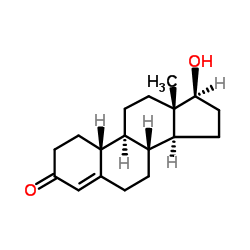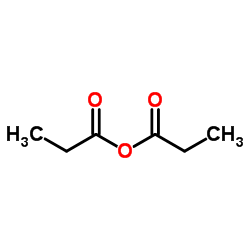7207-92-3
| 中文名 | 丙酸诺龙 |
|---|---|
| 英文名 | Nandrolone 17-propionate |
| 中文别名 | 甲醇中丙酸诺龙 |
| 英文别名 |
17β-Hydroxyestr-4-en-3-one propionate
19-Nortestosterone Propionate 19-Nor-D4-androsten-17b-ol-3-one Propionate 19-NORTESTOSTERONE 17-PROPIONATE Nortesto EINECS 230-587-0 Estr-4-en-3-one, 17-(1-oxopropoxy)-, (17β)- (17β)-3-Oxoestr-4-en-17-yl propionate N AND ROLON 17-PROPIONATE 19-nor-Testosteron-propionat (17β)-3-oxoestr-4-en-17-yl propanoate NANDROLONE PROPIONATE Norybol-19 Nandrolone 17B-propionate 17b-Hydroxyestr-4-en-3-one Propionate MFCD00198408 Nandrolone propionat 17b-(1-Oxopropoxy)estr-4-en-3-one |
| 描述 | Nandrolone propionate 是一种合成代谢类固醇,具有作用时间相对较长的特性,主要由雄激素和保氮剂组成。 |
|---|---|
| 相关类别 | |
| 参考文献 |
| 密度 | 1.1±0.1 g/cm3 |
|---|---|
| 沸点 | 453.6±45.0 °C at 760 mmHg |
| 分子式 | C21H30O3 |
| 分子量 | 330.461 |
| 闪点 | 197.1±28.8 °C |
| 精确质量 | 330.219482 |
| PSA | 43.37000 |
| LogP | 4.42 |
| 蒸汽压 | 0.0±1.1 mmHg at 25°C |
| 折射率 | 1.540 |
| 储存条件 | 室温 |
| 分子结构 | 1、 摩尔折射率:92.66 2、 摩尔体积(cm3/mol):295.2 3、 等张比容(90.2K):753.9 4、 表面张力(dyne/cm):42.5 5、 极化率(10-24cm3):36.73 |
|
Section1. IDENTIFICATION OF THE SUBSTANCE/MIXTURE Product identifiers Product name: Nandrolone 17-propionate CAS-No.: 7207-92-3 Relevant identified uses of the substance or mixture and uses advised against Identified uses: Laboratory chemicals, Manufacture of substances Section2. HAZARDS IDENTIFICATION Classification of the substance or mixture Classification according to Regulation (EC) No 1272/2008 [EU-GHS/CLP] Carcinogenicity (Category 2) Classification according to EU Directives 67/548/EEC or 1999/45/EC Limited evidence of a carcinogenic effect. Danger of serious damage to health by prolonged exposure. Label elements Labelling according Regulation (EC) No 1272/2008 [CLP] Pictogram Signal wordWarning Hazard statement(s) H351Suspected of causing cancer. Precautionary statement(s) P281Use personal protective equipment as required. Supplemental Hazardnone Statements According to European Directive 67/548/EEC as amended. Hazard symbol(s) R-phrase(s) R40Limited evidence of a carcinogenic effect. R48Danger of serious damage to health by prolonged exposure. S-phrase(s) S22Do not breathe dust. S24/25Avoid contact with skin and eyes. Other hazards - none Section3. COMPOSITION/INFORMATION ON INGREDIENTS Substances Formula: C21H30O3 Molecular Weight: 330,46 g/mol ComponentConcentration 17-ß-Hydroxyestr-4-en-3-one 17-propionate CAS-No.7207-92-3- EC-No.230-587-0 Section4. FIRST AID MEASURES Description of first aid measures General advice Consult a physician. Show this safety data sheet to the doctor in attendance. If inhaled If breathed in, move person into fresh air. If not breathing, give artificial respiration. Consult a physician. In case of skin contact Wash off with soap and plenty of water. Consult a physician. In case of eye contact Flush eyes with water as a precaution. If swallowed Never give anything by mouth to an unconscious person. Rinse mouth with water. Consult a physician. Most important symptoms and effects, both acute and delayed Some steroids show carcinogenic and teratogenic activity. Indication of any immediate medical attention and special treatment needed no data available Section5. FIREFIGHTING MEASURES Extinguishing media Suitable extinguishing media Use water spray, alcohol-resistant foam, dry chemical or carbon dioxide. Special hazards arising from the substance or mixture Carbon oxides Advice for firefighters Wear self contained breathing apparatus for fire fighting if necessary. Further information no data available Section6. ACCIDENTAL RELEASE MEASURES Personal precautions, protective equipment and emergency procedures Use personal protective equipment. Avoid dust formation. Avoid breathing vapors, mist or gas. Ensure adequate ventilation. Evacuate personnel to safe areas. Avoid breathing dust. Environmental precautions Prevent further leakage or spillage if safe to do so. Do not let product enter drains. Methods and materials for containment and cleaning up Pick up and arrange disposal without creating dust. Sweep up and shovel. Keep in suitable, closed containers for disposal. Reference to other sections For disposal see section 13. Section7. HANDLING AND STORAGE Precautions for safe handling Avoid contact with skin and eyes. Avoid formation of dust and aerosols. Provide appropriate exhaust ventilation at places where dust is formed.Normal measures for preventive fire protection. Conditions for safe storage, including any incompatibilities Store in cool place. Keep container tightly closed in a dry and well-ventilated place. Specific end use(s) no data available Section8. EXPOSURE CONTROLS/PERSONAL PROTECTION Control parameters Components with workplace control parameters Exposure controls Appropriate engineering controls Handle in accordance with good industrial hygiene and safety practice. Wash hands before breaks and at the end of workday. Personal protective equipment Eye/face protection Safety glasses with side-shields conforming to EN166 Use equipment for eye protection tested and approved under appropriate government standards such as NIOSH (US) or EN 166(EU). Skin protection Handle with gloves. Gloves must be inspected prior to use. Use proper glove removal technique (without touching glove's outer surface) to avoid skin contact with this product. Dispose of contaminated gloves after use in accordance with applicable laws and good laboratory practices. Wash and dry hands. The selected protective gloves have to satisfy the specifications of EU Directive 89/686/EEC and the standard EN 374 derived from it. Body Protection Impervious clothing., The type of protective equipment must be selected according to the concentration and amount of the dangerous substance at the specific workplace. Respiratory protection Where risk assessment shows air-purifying respirators are appropriate use a full-face particle respirator type N100 (US) or type P3 (EN 143) respirator cartridges as a backup to engineering controls. If the respirator is the sole means of protection, use a full-face supplied air respirator. Use respirators and components tested and approved under appropriate government standards such as NIOSH (US) or CEN (EU). Section9. PHYSICAL AND CHEMICAL PROPERTIES Information on basic physical and chemical properties a) AppearanceForm: solid b) Odourno data available c) Odour Thresholdno data available d) pHno data available e) Melting point/freezingno data available point f) Initial boiling point and no data available boiling range g) Flash pointno data available h) Evaporation rateno data available i) Flammability (solid, gas) no data available j) Upper/lowerno data available flammability or explosive limits k) Vapour pressureno data available l) Vapour densityno data available m) Relative densityno data available n) Water solubilityno data available o) Partition coefficient: n- no data available octanol/water p) Auto-ignitionno data available temperature q) Decompositionno data available temperature r) Viscosityno data available s) Explosive propertiesno data available t) Oxidizing propertiesno data available Other safety information no data available Section10. STABILITY AND REACTIVITY Reactivity no data available Chemical stability no data available Possibility of hazardous reactions no data available Conditions to avoid no data available Incompatible materials no data available Hazardous decomposition products Other decomposition products - no data available Section11. TOXICOLOGICAL INFORMATION Information on toxicological effects Acute toxicity no data available Skin corrosion/irritation no data available Serious eye damage/eye irritation no data available Respiratory or skin sensitization no data available Germ cell mutagenicity no data available Carcinogenicity Limited evidence of carcinogenicity in animal studies IARC:No component of this product present at levels greater than or equal to 0.1% is identified as probable, possible or confirmed human carcinogen by IARC. Reproductive toxicity no data available Specific target organ toxicity - single exposure no data available Specific target organ toxicity - repeated exposure no data available Aspiration hazard no data available Potential health effects InhalationMay be harmful if inhaled. May cause respiratory tract irritation. IngestionMay be harmful if swallowed. SkinMay be harmful if absorbed through skin. May cause skin irritation. EyesMay cause eye irritation. Signs and Symptoms of Exposure Some steroids show carcinogenic and teratogenic activity. Additional Information RTECS: Not available Section12. ECOLOGICAL INFORMATION Toxicity no data available Persistence and degradability no data available Bioaccumulative potential no data available Mobility in soil no data available Results of PBT and vPvB assessment no data available Other adverse effects no data available Section13. DISPOSAL CONSIDERATIONS Waste treatment methods Product Offer surplus and non-recyclable solutions to a licensed disposal company. Contact a licensed professional waste disposal service to dispose of this material. Dissolve or mix the material with a combustible solvent and burn in a chemical incinerator equipped with an afterburner and scrubber. Contaminated packaging Dispose of as unused product. Section14. TRANSPORT INFORMATION UN number ADR/RID: 2811IMDG: 2811IATA: 2811 UN proper shipping name ADR/RID: TOXIC SOLID, ORGANIC, N.O.S. (17-ß-Hydroxyestr-4-en-3-one 17-propionate) IMDG: TOXIC SOLID, ORGANIC, N.O.S. (17-ß-Hydroxyestr-4-en-3-one 17-propionate) IATA:Toxic solid, organic, n.o.s. (17-ß-Hydroxyestr-4-en-3-one 17-propionate) Transport hazard class(es) ADR/RID: 6.1IMDG: 6.1IATA: 6.1 Packaging group ADR/RID: IIIMDG: IIIATA: II Environmental hazards ADR/RID: noIMDG Marine Pollutant: noIATA: no Special precautions for user no data available SECTION 15 - REGULATORY INFORMATION N/A SECTION 16 - ADDITIONAL INFORMATION N/A |
| 危害码 (欧洲) | Xn: Harmful; |
|---|---|
| 风险声明 (欧洲) | R40;R48 |
| 安全声明 (欧洲) | S22-S24/25 |
| 危险品运输编码 | UN 2811 |
| 包装等级 | III |
| 危险类别 | 6.1(b) |




